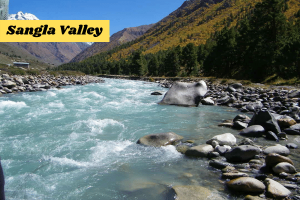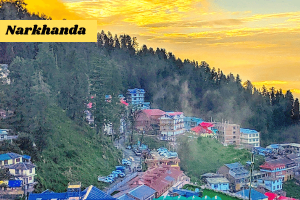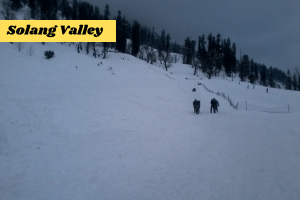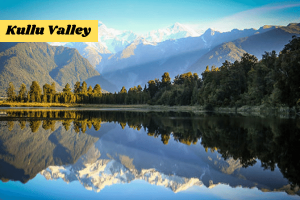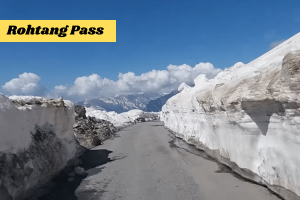Himachal Pradesh is famous for its abundant natural beauty. After the war between Nepal and Britain, also known as the Anglo-Gorkha War (1814-1816), the British colonial government came into power. In 1950 Himachal was declared a union territory, but after the State of Himachal Pradesh Act 1971, Himachal emerged as the 18th state of the Republic of India. Hima means snow in Sanskrit, and the literal meaning of the state's name is In the lap of Himalayas. It was named by one of the great Sanskrit scholars of Himachal Pradesh, Acharya Diwakar Datt Sharma.
Like Most Other States In India, Himachal Pradesh Is Also Rich In Traditional Paintings. You Can See The Miniature Paintings In Art Galleries And Museums In Himachal, But The True Picture Of The Traditional Paintings Can Be Seen In Most Village Houses. The Women Of The House Paint Their Floors And Walls. Moreover, They Draw Illustrative Designs Called Yantras On The Doorstep On Ceremonial Occasions. The Floors Are Decorated With A White Paste Made Of Rice, Whereas The Walls Are Painted With Colors, Which They Collect From Daily Used Things Such As Turmeric Powder, Red Clay, Kumkum (a Liquid Used For Make Up) And So On.
Thangkas
Thangkas Are Brightly colored Cloth Paintings, Which Are Mostly Used As Ritual Paintings Exhibited During Some Buddhist Festivals. International Tourists Love These Paintings. They Generally Depict Lord Buddha And Other Deities As Well As The Wheel Of Life.
Rugs & Carpets are Significant Part Of Furnishing In Himachal Pradesh. Available In Brilliant Colors And Traditional Motifs These Items Look Amazingly Beautiful In Appearance. Moreover, Blankets Made With Wool Weaved Out Of Sheep And Goats Are Also Available In Plenty.
| Area | 55,673 sq km |
|---|---|
| Capital | Shimla |
| Population | 6,856,509 |
| Official Languages | Hindi |
| Boundary | Himachal Pradesh is a state in Northern India. It is spread over 21,495 sq mi (55,670 km2), and is bordered by Jammu and Kashmir on the north, Punjab on the west and south-west, Haryana and Uttarakhand on the south-east and by the Tibet Autonomous Region on the east. |
(dholru) Is The First Month Of The Lunar Year And The First Day Of The Month Is Cellebrated With A Belief To Bring Hapiness And Prosperity. This Festival Is Known As Chatrali In Kullu And Dholru In Bharmaur Area Of Chamba District. In District Kangra, Hamirpur And Bilaspur, First Day Of Chet Month Hold Special Importance.
India Is A Land Built On Foundation Of Diversity, And Himachal Pradesh Is No Exception. While The Majority Of The Population Is Of Aryan Stock And Are Devoteed Hindus, Their Is Ample Represention Of Buddhism, Especially In The North, And Islam. The People Of Lahaul Spiti Are Mangol Stock, And Display The Facial Features Associated With The East. Life In The Hill State Is Essentially Rural, With Only A Silver Of The Population Living In Urban Settlements. Farming And Livestock Are The Main Occupations. Asides These Common Traits, There Is Plenty To Differentiate The People Of Different Regions From Each Other. Each Area Has Its Own Style Of Dressing, Its Own Customs And Rituals. And Not Least, Its Own Gods.
Cooked Only By A Special Category Of Brahmans, Dham Is A Meal Whose Preparation Begins One Night Before The Actual Lunch Is To Be Served On Traditional Leaf Plates. In Chamba, The Characteristic List Of Options For A Dham Would Begin With Rice, Moong Dal (green Lentil Broth) And Rajma (red Kidney Beans) Prepared. This Merriment Makes Way For The Boor Ki Kari And A Dark Lentil (mash Dal). Completed By Khatta (sweet And Sour Sauce) Prepared With Gur (jaggery) And Tamarind, The Dham Punctuates Itself With A Mittha (dessert) – Sweet Rice, Generously Mixed With Dry Fruits.
The Various Kinds Of Handicrafts Available In Himachal Pradesh Include Woodwork, Leather Embroidery, Metal Wares, Carpets, Painting And Woolen Textiles. The Range Of Handicrafts Found In Himachal Is Unique To The State. The Crafts Of This State Are Vast And Portray The Artistic Skill Of The Craftsmen. Thangka Is An Intricate And Brightly Colored Painting Done On Cloth a Very Famous Art Of Tibetan Artisans. These Paintings Mostly Depict Buddha As Well As Other Gods And Goddess. This Art Is Very Popular Especially With Foreign Tourists Himachal Also Specializes In Making Fine Shawls. Moreover, Accessories, Embroidery, Woolen Garments And Leather Craft Of Himachal Is Extremely Precious And Popular. Wood Carving : Being Rich In Forests, Wood Is Abundant In Himachal Pradesh And So Woodcarving Is Still A Living Tradition Of The State. Earlier This Craft Was Mostly Used In Building Temples And Palaces. However, At Present Artisans Creates Intricate Designs Used In Building Houses, And Also For Making Other Things Like Low Benches, Spinning Wheels, Smoking Pipe, Cradles, Low Settees, Boxes, Serving Spoon, Rolling Pins, Wooden Utensils, And Much More. Moreover, Other Interesting Things Like Fruit Bowls, Beer Mugs, Wooden Jewellery, Decorative Boxes And Carved Images Can Also Be Found Carved Out Of Wood.
Dharamshala or Dharamsala city is located in Kangra district at 18 km from Kangra city in Himachal Pradesh. The state’s winter capital, Dharamshala, is separated as upper and lower divisions with different altitudes. The lower division is the Dharamsala town itself, whereas the upper division is located 3 km away and is popularly known as Mcleodganj. Dharamsala is prominently visited for the bus connections and the bustling market.
Dharamsala is the home to Dalai Lama, the Buddhist leader who runs his government in exile from Dharamsala. Now, what better place on earth than this little town set on the foothills of Dhauladhar ranges to experience the rich and regal Tibetan culture.
In 1959, Dalai Lama came to India with his followers and settled, rather beautifying the town of Dharamsala, transforming it into the little Lhasa. Dharamsala, for many years, has been a centre of meditation and peace.
Dalhousie is a popular hill station in Himachal Pradesh, boasting views of the snow-capped peaks of the Dhauladhar ranges. Dalhousie is famous for its meadows, dense jungles, and waterfalls. It is especially famous amongst honeymooners and family vacationers.
Established in 1854, the valley is named after Lord Dalhousie, and was one of the favourite summer destinations of the Britishers during the colonial era. Dalhousie offers an old-world charm, mesmerizing natural landscapes, pine-clad valleys and magnificent misty mountains. The Scottish and Victorian-era architecture of churches reminds of its colonial heritage.
Dalhousie is also known for woollen Himachali shawls, Tibetan handicrafts, Chamba handkerchiefs, and other paraphernalia. These can be bought from The Mall Road which is the town’s main market.
If you are planning a trip to Dalhousie, you must include Khajjiar in your itinerary. Known as the mini Switzerland of India, Khajjiar is just 21 km away. The little hill town is famous for its spellbinding vistas of mountains loaded in white snow and lush green pastures of land. Kalatop Wildlife Sanctuary in Khajjiar is famous for an exquisite variety of endangered species and breathtaking views of the mountains in the backdrop. Chamba, located almost 50km from Dalhousie, is also worth visiting.
Often referred to as ‘mini-Switzerland of India’, Khajjiar is a small town located close (20km) to Dalhousie and is great for a day or overnight trip. Khajjiar is known for its picture perfect grassy meadows.There is a small lake in the middle of the meadow and you could enjoy the scenery by yourself or take part in some of the adventure sports including paragliding, zorbing, and horse-riding.
Located at an altitude of 6,500 feet, Khajjiar is also known for its nine-hole golf course which is nestled in the midst of lush greenery and a breathtaking landscape. However, the way to Khajjiar can be closed sometimes during winters because of heavy snowfall. Visit Kalatop Wildlife Sanctuary on your way from Dalhousie to Khajjiar.
The mesmerizing beauty of this place has greatly influenced and inspired many kingdoms throughout the years, including the Rajputs and Mughals. The Khajji Nag temple was built in the 12th century and has been attracting devotees ever since.
One of the most charming valleys in the whole Kinnaur District, Sangla Valley is a perfect getaway from the hustle bustle of the swarming cities. It is named after a beautiful village by the same name.
Bounded by strapping mountain slopes, sprawling evergreen forests and snow covered peaks, the valley is set apart from others by its red apples orchard and luscious cherry trees. Baspa River also makes its way through the place, meandering and gurgling, famous for trout fishing. The place is dotted with several attractions from temple and fort to nearby villages making it an amazing holiday destination.
Kalpa, the main village of Kinnaur, in the Sutlej River Valley is a place to remember and cherish. Known for its many beautiful temples and monasteries, this town is also famed for its apple orchards. The majestic Kinnaur-Kailash range peeking from across the Sutlej River makes for a blissful break.
An early morning walk through this paradise will give you a chance to experience magic and mystery with the sunrise. The pinkish hue on the peaks that slowly gets tinted with the golden glow is a sight to behold. Adorned with rich flora and fauna, this small hamlet is a must visit destination.
Chandigarh was a created to fulfill the need of a permanent capital of Punjab and Haryana, although Shimla was a temporary headquarters in those times. Chandigarh, the capital of both Punjab and Haryana, is the first Indian city to have been designed and planned by a single architect – Le Cobusier. The city, a model of wide roads and spacious residential colonies, is an excellent base for specialized sightseeing. The white domed temple of Goddess Chandi Devi that stands on the slope of a hill, situated in the north-east of Chandigarh, on the edge of the Shivalik hills, is from where the city obtains its name Chandigarh. From here one can travel northwards to the hill resorts of Shimla, Kullu, Manali, Dharamshala and Dalhousie. Chandigarh is not only the most modern city in the country but has been planned to perfection by the world famous French architect le Cobusier.
General Information
Altitude: 304.8 to 365.78 meters
Climate:(deg C)- Summer- Max 37, Min 23,
Winter- Max 24, Min 5
Rainfall: 111.4 cms
Best Season: October to March
TRANSPORT AND COMMUNICATION
Air: Well connected with Delhi, Jammu, Shrinagar and Leh.
Rail: Well connected with major towns.
Road: Chandigarh is well connected with roads from —
Amritsar- 240 km Kullu- 279 km
Dehradun- 230 km Bhakra- 116 km
Delhi- 248 kmKasauli- 77 km
Shimla- 117 kmJammu- 380 km
ARCHITECTURE OF CHANDIGARH
Chandigarh is a grand success story in the annals of modern architecture. It combines architectural elegance with wide tree lined avenues and green belts. In 1951 the world renowned Architect, Le Corbousier developed the city plan and designed the capital complex. The idea of vertical planning was ruled out and it was decided to build the city horizontally. The master plan divides the city into rectangular modules called sectors, each one measuring 800 meters X 1200 meters with a population varying from 5000 to 20,000. Each sector is provided with a shopping complex, school, health centre, places of recreation and places of worship. Chandigarh has 47 sectors except for sector number 13.
PLACES OF INTEREST
The Secretariat — The Secretariat is the largest building in the Capitol Complex and is the headquarters of both the Punjab and Haryana governments. It is one of the Capitol buildings and houses all the ministries. The Secretariat and Vidhan Sabha (Legislative Assembly) buildings are in Sector 1.
Zakir Hussain Rose Garden — Zakir Gulab Baag is Asia”s largest Rose garden, spread out over 30 acres of land, in sector 16. Established in 1967, today around 50,000 Rose trees of 1600 different species bloom here. Apart from roses, the other trees planted have medicinal value and some unique specimen trees were planted to enhance the beauty of the garden. The garden is located next to the city centre.
Rock Garden — The Rock Garden of Chandigarh has been created by putting together the fossils of ancient life forms found in the Shivalik hills and by recycled waste material. Its creator, Nek Chand, was an inspector in the engineering department. Rock fossils have been arranged into an open air sculpture exhibition. Some of the sculptures include a wall made out of discarded fluorescent tubes, an army of clay monkeys and broken chinaware soldiers and shapes of women made out of discarded glass bangles. The garden covers an area of 6 acres.
In summers, it is open from 9:00 am to 1:00 pm and again from 3:00 pm to 7:00 pm. From October to March it is open from 9:00 am to 1:00 pm. and 2:00 pm to 6:00 pm
Sukhna Lake — Another tourist attraction in Chandigarh is the Sukhna Lake spread over an area of 3 sq. km in sector 6. The waters of a seasonal rivulet that ran through the city were impounded to create the Sukhna Lake. Migratory birds arrive here from Siberia during the winter. A love for the lake draws many volunteers to desilt it just before the monsoon rains set in. While the lake promenade is a place for peace and tranquillity, the area just at the entrance has been developed for children to enjoy themselves.
Govt. Museum & Art Gallery & Punjab University Complex — Located in sector 14, the parks and pools around the university building have enhanced the feel of the whole area. The Punjab University was founded in 1882 at Lahore. After partition and initial dislocation, the University shifted to Chandigarh in 1956. It is as famous for it”s landscaping as for its architectural.
Leisure Valley — During the monsoon, there runs a natural storm-water channel through the middle of the city, locally called a nullah. The nullah, along with the adjoining land has been converted into what is called the leisure valley. Starting from the foot of the hills to the west of the Capitol Complex, the leisure valley extends into sector 3 and crosses over into sector 10. The leisure valley is spread over 6 km and in accordance with the plan no vehicular traffic interrupts a pedestrian taking a walk in the park.
Pinjore Gardens- 25 km — Located a short distance from Chandigarh, on the Pinjore-Kalka road is the Pinjore Yadvindra Gardens. This is a traditional Mogul style garden, created in the 17th century by Nawab Fidal Khan, architect to the Mogul emperor Aurangzeb. These gardens were developed along a slope with a central channel of water in which fountains were placed at regular intervals. On either side of the channel are spacious walkways with shady trees and a carpet of green grass. Pinjore Garden is a favorite picnic spot for the citizens of Chandigarh. It is open on all days and accommodation is available at Rang Mahal and Sheesh Mahal.
The Assembly & High Court
International Doll Museum
National Gallery of Portraits.
EXCURSIONS:
Bhima Devi Temple- 22 km
Chattbir Zoo- 22 km
Mansa Mandir / Chandi Mandir- 10 km
Bhakra Nangal- 116 km
Ponta Sahib- 135 km
Naina Devi- 110 km
